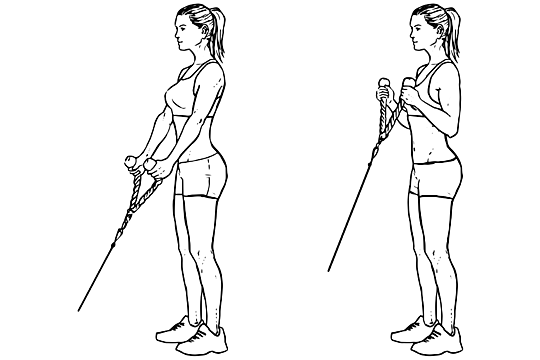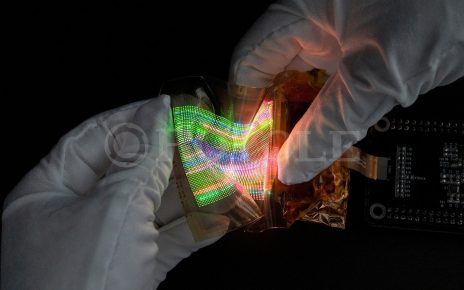Firm and shapely arms from your fingertips to your shoulders look great any time of the year, but what do you do if your arms are a little softer or not quite as toned as you wish they were? You just have to face facts; it is really impossible to hide your arms for the entire summer. Unfortunately, it is just too easy to lose your arm firmness after a winter of hibernation and reduced activity during the pandemic. Sure, you can wear sweaters in the spring and cover up with baggy sweatshirts for a while, but unless you live in the Antarctic, your arms will have to come out into the sunlight at some point. Even endless hours of cardio and dieting during the winter will not firm your arms. As the summer months are approaching, there is still time to work toward tight and shapely arms that will give you an entirely new look for the warmer weather.
Your anterior arms will get some indirect activation if you routinely do some form of rows or pulldowns for your back. However, to achieve the goal of firm and shapely anterior (front) arms, you will need some direct arm work, and hammer rope curls will get the job done quickly. The “hammer” title describes the mid-prone hand position during the exercise, as if you were holding a hammer in your hands. It activates all of the primary and secondary movers of your anterior arms and forearms. Do not worry about bulking up your arms with this exercise since you will not need heavy weights for hammer rope curls to stimulate your muscle fibers.
The brachialis muscle of the upper arm is strongly activated by hammer rope curls. It is covered by the biceps and not visible except for the lower and outer parts; however, it is a very important flexor of the elbow joint and it still contributes significantly to the overall shape of your upper arm. This muscle begins on the humerus bone of the upper arm about two-thirds of the way from the elbow to the shoulder and it crosses the anterior part of the elbow joint, where it becomes anchored to the ulna bone near the elbow joint. The ulna bone lies closest to the little-finger side of the forearm. This attachment to the ulna prevents the brachialis from having any role in supination, but when the hands are semi-pronated or pronated, it is a very strong elbow (forearm) flexor. The semi-pronated (neutral) hand position during hammer rope curls ensures that the brachialis muscle is fully activated throughout the exercise.
The biceps brachii muscle has two parts. The short head of the biceps attaches to the coracoid process, a little beak-like projection from the anterior-lateral side of the scapula (shoulder blade). The long head of the biceps brachii attaches to the supraglenoid tubercle, a little bump over the shoulder joint on the scapula. Both heads of the biceps come together and attach to the radius bone of the forearm via the bicipital tendon. The radius bone (the most lateral forearm bone) forms a combination rotational-pivot joint and hinge joint at the elbow. The biceps becomes an effective forearm flexor, when the hands are supinated (the palms turned toward the ceiling). This is because supination rotates the radius bone, which tightens the biceps. In contrast, the biceps brachii is a very poor elbow flexor when the hands are pronated, because this rotates the radius so that it sits on top of the ulna and this position slackens the biceps muscles. In hammer rope cable curls, the hands are semi-pronated, which “unloads” the biceps a bit to concentrate more fully on the brachialis of the upper arm, but the biceps are still stimulated quite strongly.
The brachioradialis muscle is primarily a forearm muscle, but it helps to provide the firm continuity from the arm to the forearm. It is also an accessory muscle to help elbow flexion. The brachioradialis muscle attaches proximally to the lateral ridge of humerus bone just above the lateral epicondyle of the elbow and it attaches distally by a long tendon along the lateral side of the distal end of the radius bone near the wrist. It does not cross the wrist, so it can only flex the elbow and it therefore assists the biceps and brachialis in hammer rope curls.
Hammer Rope Curls
1. Attach a Y rope handle to the cable from the bottom of the cable pulley station. Make sure the end of the rope has a large knot or a solid plastic knob to keep your hands from slipping off.
2. Grab each part of the Y rope. Turn the hands so the palms are facing each other. This is a semi-pronated grip and your hands will stay in this position throughout the exercise.
3. Back away from the cable machine so that your feet are about 2 to 3 feet from the base of the pulley unit. Your back should be straight and tight, but your knees should not be locked straight. Your feet should be placed at hip-width.
4. Start with your elbows straight and the hands in front of the thighs.
5. Keeping your elbows close to the sides of your torso, take a breath and exhale as you flex the elbow and pull the hands up toward your shoulders.
6. Keep your elbows back and tight to the side of your ribs as you are completing the repetition. Your forearms should be moving, but your upper arms should not be moving at the shoulder. Continue to curl until your hands are as close to your shoulders as possible.
7. Lower the rope back to the starting position by controlling the weight downward as you inhale.
8. Stop just before the elbows are completely straight, then start the next repetition upward.
The arms are typically among the most challenging areas for women to tone. Part of the reason is that fat is readily deposited in the arms of women. The other primary reason is that unless you achieve direct exercise for the arms, there is little to stimulate and tone the underlying musculature. Proper dieting, resistance training and cardiovascular activity are all required to reduce your subcutaneous fat and improve the shape of your arms. Resistance training is really the only way that will help you tone and firm your anterior arms, but alone, it will not eliminate much excess fat that you might have on your arms. For strengthening and toning your arms, there are many exercises you can do, but hammer rope curls will be excellent at activating your anterior arms and forearm muscles. Hammer rope curls will not build muscle mass, which is reasonable, because they are not designed to build muscle mass. However, this exercise is an excellent finishing exercise for your arm workout and it will definitely improve the firmness and shape of your upper arms.
Good form is important if you are going to get the most out of it for your biceps, brachialis and brachioradialis muscles. It is important to use enough resistance so that your arms fatigue within 12 to 15 repetitions. If the resistance is too light, then you will not obtain the shape and muscle firmness that you will want. You should also try to keep the rests between sets to 90 seconds or less. It is acceptable to allow the arms to move slightly forward when the elbow is fully flexed, but the upper arms must remain as close to perpendicular to the floor as possible to ensure a full, aching contraction during the curl.
If the outside (lateral part) of your upper arm is soft or more shapeless than you would like, you should try extra hard to keep the elbows and arms back when you are doing the curls. This will stretch the long head of the biceps brachii and thereby activate this muscle head more fully during each curl upward. This helps to shape and firm the outer parts of the upper arm so that the arms look great at any angle. You can also add a bit of supination to the movement on the way up rather than keeping the semi-pronated “hammer” positions. Supinating the hands while you are lifting the weight upward will increase the recruitment of the biceps brachii; however, do not forget to pronate the hands back to the hammer position as the weight is lowered.
Arm development is critical if you want to look great around the pool, or if you need to firm up your arms after your serious dieting has paid off. Dieting and cardio will reduce your body fat and shrink the fat around your arms, but without direct resistance exercise, they will not help to firm and shape and tone your arms. If great arms are something that you want to have this summer, and if you are having a little trouble keeping on track, why not get a gym partner who has similar goals? Together you can achieve a great arm structure in only a few months and hammer rope curls are a great start to unveil your new summer arms.
References:
Basmajian JV and CJ DeLuca. Muscles Alive, 5th Ed. Baltimore, Williams & Wilkins, 1985, pp. 285-286.
Clemente CD. Anatomy, A Regional Atlas of the Human Body. Second edition, Baltimore, Urban & Schwarzenberg Pub. Co. p.43-55, 1981.
Kostek MA, Pescatello LS, Seip RL, Angelopoulos TJ, Clarkson PM, Gordon PM, Moyna NM, Visich PS, Zoeller RF, Thompson PD, Hoffman EP and Price TB. Subcutaneous fat alterations resulting from an upper body resistance-training program. Med Sci Sports Exerc, 39: 1177-1185, 2007.
Nickols-Richardson SM, Miller LE, Wootten DF, Ramp WK and Herbert WG. Concentric and eccentric isokinetic resistance training similarly increases muscular strength, fat-free soft tissue mass, and specific bone mineral measurements in young women. Osteoporos Int, 18: 789-796, 2007.
Pescatello LS, Kelsey BK, Price TB, Seip RL, Angelopoulos TJ, Clarkson PM, Gordon PM, Moyna NM, Visich PS, Zoeller RF, Gordish-Dressman HA, Bilbie SM, Thompson PD and Hoffman EP. The muscle strength and size response to upper arm, unilateral resistance training among adults who are overweight and obese. J Strength Cond Res, 21: 307-313, 2007.
Sarsan A, Ardic F, Ozgen M, Topuz O and Sermez Y. The effects of aerobic and resistance exercises in obese women. Clin Rehabil, 20: 773-782, 2006.
The post Get Strong and Shapely Arms for Summer first appeared on FitnessRX for Women.




